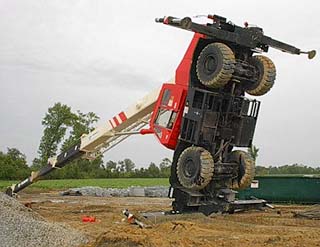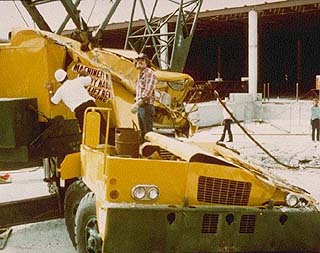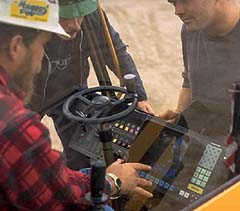
Surveys
Awards
DJC.COM
March 25, 2004
More training needed for crane operators
Special to the Journal

Photos courtesy of Ronald Cowper
Poor set-up accounts for over 60 percent of all crane tip-overs.
|
U.S. Department of Labor statistics indicate that from 1984 to 1997 construction fatalities averaged about 1,150 individuals a year, of which crane-related fatalities averaged about 50 a year.
It was perceived that with the introduction of voluntary operator certification across the country, job-site safety, at least in the area of crane operation, would be greatly improved and the number of crane-related accidents would show a significant decline. In the period from 1997 to 2000, when it was too early in the certification process to properly evaluate any noticeable change in the pattern, crane-related fatality statistics remained consistent with the previous years.
With thousands of operators across the country currently NCCCO certified and more public agencies endorsing the certification program, one would tend to believe that, as OSHA suggests, “certification is having a significant and positive impact” in reducing crane accidents. However, information provided by craneaccidents.com, a Web site that monitors accidents, injuries and fatalities worldwide, indicates that from the beginning of 2000 to the end of 2003 the average number of crane-related fatalities in the United States had actually risen to 55.5 per year.
Craneaccidents.com also reported that in 2003 alone 60 workers died in crane-related accidents while another 60 were injured in about 200 reported incidents. By the end of February 2004, the Web site reported that there have already been 15 crane-related fatalities, which is on pace for another above average year.
How can this be? What could be wrong with the system?
Crane operator certification
I have always been a firm supporter of certification for crane operators, but I, as well as many others, believe that the criteria for obtaining that certification needs to be more stringent.
Cranes have become more complicated and versatile, and individuals who are required to work around them have the right to expect that the people operating them are well trained, knowledgeable and highly skilled.
I do not believe the 1,000 hours of experience, with no specific training requirements, that is required to obtain CCO certification is sufficient to provide the experience base that a fully qualified crane operator needs to be able to make many of the varied and sometimes critical decisions. Good operators will tell you that, while the less qualified ones aren't about to fight to have the system changed.

Crane accidents cause damage, injury and death.
|
I also believe that the quality and amount of actual training being supplied is inadequate in many cases. There are too many one-, two- and three-day training programs that are geared to those less skilled individuals who just want enough knowledge to be able to pass the written test.
By comparison Ontario, Canada, has had voluntary crane operator certification for almost 100 years that became compulsory in 1983. Also, Canada has had a National Crane Operator Certification and Apprenticeship program since 1999 that requires a minimum of 2,000, 4,000 or 6,000 hours of hands-on experience and classroom training, depending on provincial requirements and the crane classification being applied for.
We know this system works because Canada's exceptionally low accident and fatality rate is envied around the world.
When I was first asked to conduct crane operator training in Washington state in 1993, it was with the expectation that compulsory certification was virtually a guarantee. Sadly it was not to be. Surely it makes little sense when plumbers, electricians, auto mechanics and hairdressers, to name a few, are required to be trained and certified but individuals who operate the most expensive and dangerous tool on the jobsite are not.
Management's responsibility
It is generally agreed among crane operators that although everyone involved in the lifting operation is interested in completing the job safely, the operators are frequently challenged by supervisors to perform lift procedures that are questionable.
Crane operators feel that too often jobsite supervisors are either not sufficiently informed in the functions and limitations of the crane or are more focused on getting the job done. Although upper management is most often not directly involved in the day-to-day site operations, any internal safety program must begin at that level or it will be doomed.

Training needs to be comprehensive and ongoing.
|
If management claims to promote safe working practices but tends to look the other way when productivity becomes more important, or when complaints of unsafe practices made to safety committees are not effectively acted upon, employees, including site supervision, may quickly assume that management is not too committed to safety.
It has been said, “what management permits, management condones.” But if something goes wrong, management will ultimately be held morally, legally and financially responsible for the safety of its project.
National Safety Council estimates put the cost of one lost-time accident at about $27,000, with punitive damages sometimes ranging into the millions of dollars. Management that is seriously interested in promoting jobsite safety will quickly learn that the money spent on just one lost time accident could easily cover the cost of providing comprehensive and ongoing safety training programs for their operators, site managers and supervisors.
Without that training and the unqualified backing of management to always do the job with the highest regard for safety, job-site personnel are inclined to continue in their ways, which allows serious crane accidents and death to continue.
Ron Cowper has been providing crane safety training programs to operators, riggers, site supervisors and Department of Labor compliance officers from across Canada and the United States since 1983.
Other Stories:
- Spiking costs shadow construction market
- Beware of vulnerabilities during construction
- Construction industry struggles to accept ISD
- The roots of Washington's new building code
- Government takes a shine to alternative bids
- New laws have yet to stem tide of condo suits
- Sleep and safety make sound partners
- WSU students train for the Solar Decathlon
- An ACE in the hole for high schoolers
- Do you know who your successor is?
- Six ways to keep your customers happy
- How ergonomics can fatten the bottom line
- Shattering the myth of wired glass
- Want big profits? Make yours a high-trust company
- Equipment costs don't have to break the bank
- Listen up workers: act quickly on hearing loss
- In a lawsuit? Who's paying the lawyers?
Copyright ©2009 Seattle Daily Journal and DJC.COM.
Comments? Questions? Contact us.